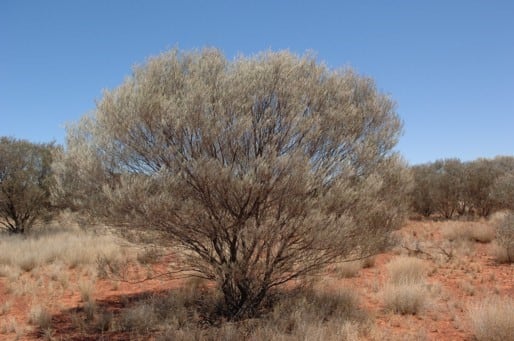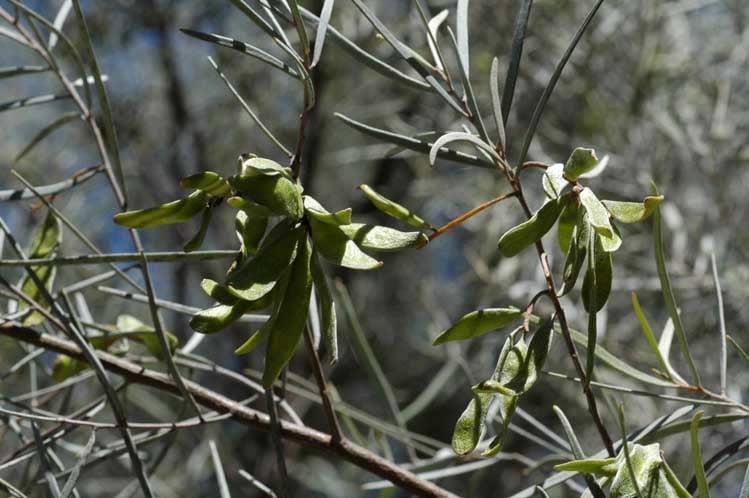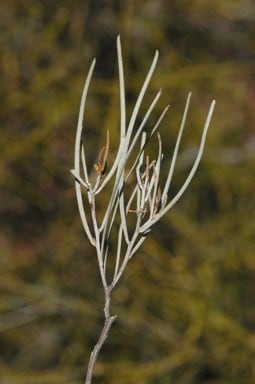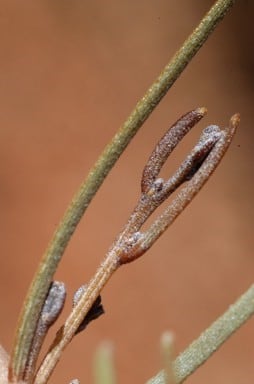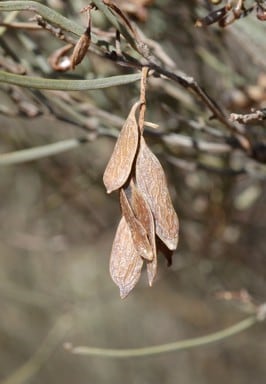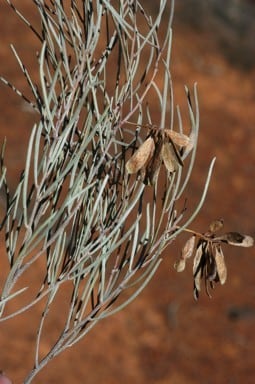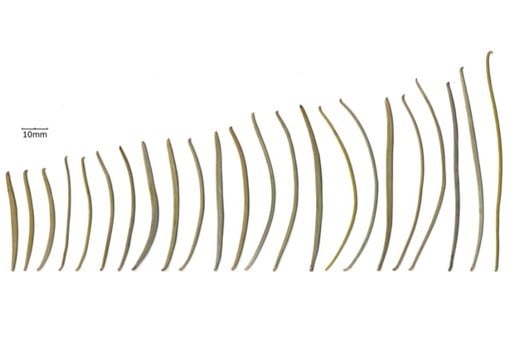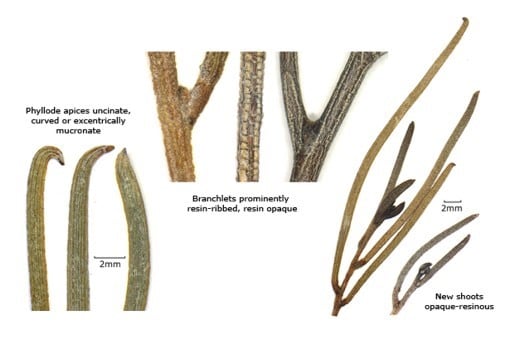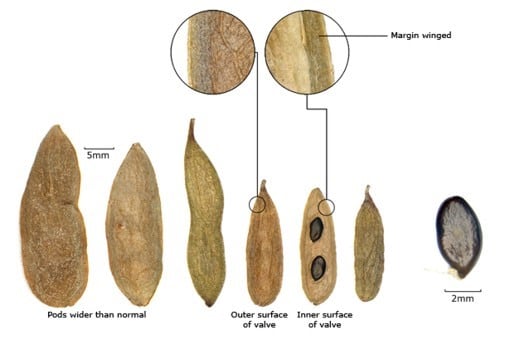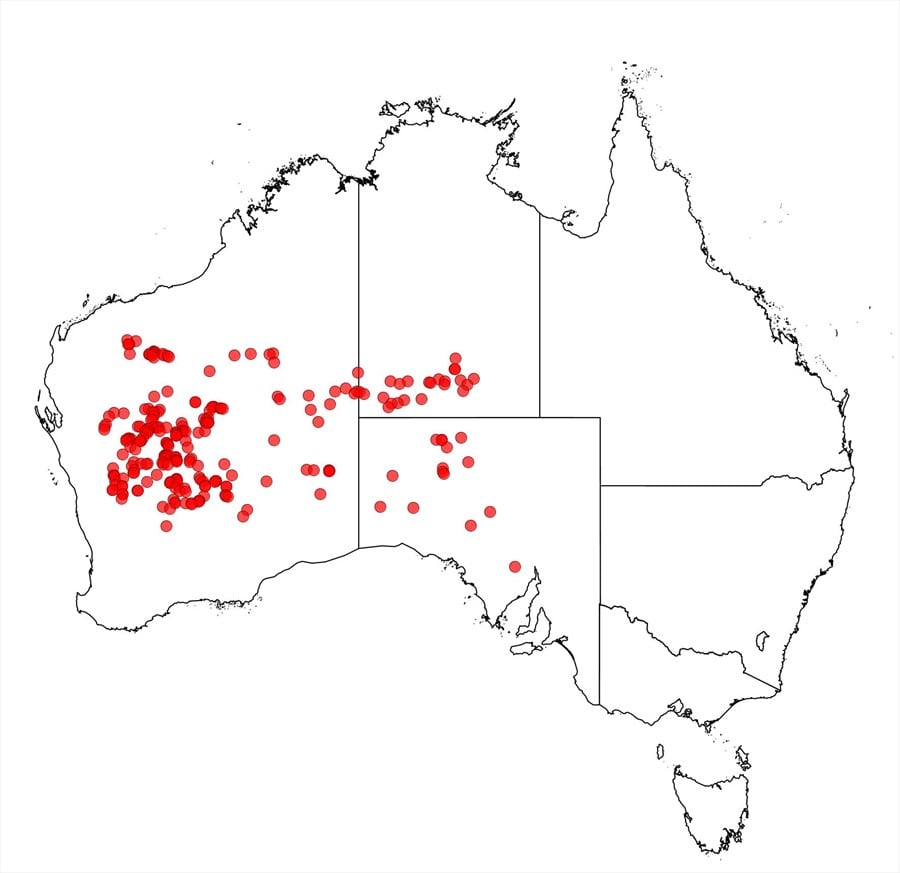Acacia incurvaneura Maslin & J.E.Reid
WATTLE
Acacias of Australia
Common Name
Narrow-leaf Mulga
Family
Fabaceae
Distribution
Widespread in W.A. where it extends eastwards from the longitude of Yalgoo (c. 117°E) and from Tom Price S to the latitude of Kalgoorlie (c. 31°S); extending to NW S.A. and SW N.T.
Description
Rounded or obconic, multi-stemmed shrub 2.5–5 m high and 3–6 m wide, maturing to tree to 6 (–8) m, crowns dense to sub-dense. Branchlet ribs normally covered by a ±thick layer of opaque, yellowish resin that becomes segmented and often persists as beaded white lines on mature branchlets; new shoots resinous, developing phyllodes striate with white appressed hairs between resinous longitudinal nerves. Phyllodes ascending to erect, mostly shallowly or moderately incurved, narrowly linear, not rigid, terete to flat, (3–) 4–8 (–9) cm long, (0.8–) 1–2.5 (–3) mm wide, apices normally uncinate to sub-uncinate or curved, normally grey-green to greyish or sub-glaucous, indistinctly multistriate; gland obscure, basal. Inflorescences simple; peduncles 3–6 mm long; spikes (1–) 1.5–2 cm long. Flowers 5-merous; sepals free, ⅓–½ length of petals, oblong; petals 1–1.3 mm long. Pods oblong to narrowly oblong or fusiform, 1–4 cm long, (4–) 5–8 (–10) mm wide including wings, chartaceous, flat, glabrous, brown but often tinged greyish, often scurfy, ±longitudinally reticulate; marginal wing 0.5–1 mm wide, indistinct. Seeds oblique, 3.5–4 mm long, 2–2.5 mm wide, oblong to slightly elliptic; aril small and white.
Habitat
Grows in a range of habitats but commonly in red-brown sandy loam on plains or in gently undulating country, often over hardpan at a relatively shallow depth, and in skeletal soil on breakaways or low rocky hills. Found in mixed Acacia shrubland or woodland communities, often in association with A. caesaneura.
Specimens
W.A.: 40 km W of Windy Corner, Gibson Desert, P.K.Latz 17868 (PERTH); 41.8 km S of Mt Magnet towards Paynes Find, B.R.Maslin 3573 (PERTH); Hamersley Ra., c. 59 km W of Newman on rd to Port Hedland, B.R.Maslin 8029 (BRI, CANB, PERTH); 5.5 km N of Menzies on Goldfields Hwy to Leonora, B.R.Maslin & J.E.Reid BRM 9716 (AD, PERTH). N.T.: 37 km SSW of Mt Olga on track to Foster Cliff, D.E.Albrecht & P.K.Latz 13151 (PERTH: phyllodes at lower end of length range). S.A.: Wirrealpa, Black Oak Ra. in the Northern Flinders Ra., 18 Oct. 1946, H.M.Cooper s.n. (AD: identity needs confirming).
Notes
A member of the ‘A. aneura group’ (Mulga) most closely related to A. caesaneura and A. mulganeura with which it is commonly sympatric; these species can hybridize to form complex populations. Also not far removed taxonomically from A. minyura. Acacia incurvaneura is most readily distinguished from these relatives by a combination of its resinous new shoots and narrow, linear, mostly incurved phyllodes. Acacia incurvaneura appears also to occasionally hybridize with A. aptaneura, A. ayersiana, A. fuscaneura and A. pteraneura. See B.R.Maslin and J.E.Reid, Nuytsia 22(4): 129–267 (2012), for discussion of hybridity involving the above-mentioned species.
Phyllodes of A. incurvaneura vary from terete to flat and both types can co-occur in the one population. Plants with shorter than normal phyllodes (3–5 cm) are scattered throughout the range of the species and are sometimes sympatric with those possessing normal phyllodes (mostly 5–8 cm long). Pods are normally 5–7 (–8) mm wide but on a few specimens they reach 10 mm and these require further study. B.R.Maslin and J.E.Reid, loc. cit., provide a discussion of variation within this species.
This taxon was treated as A. aneura var. microcarpa by L.Pedley, Fl. Australia 11B: 317 (2001), but B.R.Maslin & J.E.Reid, loc. cit., consider it warrants recognition as a distinct species.The specimens A.S.George 8191 and K.F.Kenneally 52A that were cited by L.Pedley, loc. cit., under A. aneura var. microcarpa are A. pteraneura, the first being the narrow-pod variant of that species.
FOA Reference
Data derived from Flora of Australia Volumes 11A (2001), 11B (2001) and 12 (1998), products of ABRS, ©Commonwealth of Australia
Author
B.R.Maslin
L.Pedley
This identification key and fact sheets are available as a mobile application:
URL: https://apps.lucidcentral.org/wattle/
© Copyright 2018. All rights reserved.
